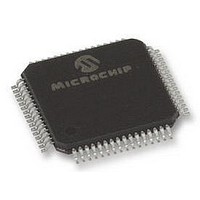DSPIC30F5011-30I/PTG Microchip Technology, DSPIC30F5011-30I/PTG Datasheet - Page 153

DSPIC30F5011-30I/PTG
Manufacturer Part Number
DSPIC30F5011-30I/PTG
Description
16BIT MCU-DSP 30MHZ, SMD, 30F5011
Manufacturer
Microchip Technology
Series
DsPIC30Fr
Datasheet
1.DSPIC30F5011-30IPTG.pdf
(220 pages)
Specifications of DSPIC30F5011-30I/PTG
Core Frequency
30MHz
Embedded Interface Type
CAN, I2C, SPI, UART
No. Of I/o's
52
Flash Memory Size
66KB
Supply Voltage Range
2.5V To 5.5V
Operating Temperature Range
-40°C To
Lead Free Status / RoHS Status
Lead free / RoHS Compliant
- Current page: 153 of 220
- Download datasheet (4Mb)
21.0
The
enhancements to the previous PICmicro
sets, while maintaining an easy migration from
PICmicro instruction sets.
Most instructions are a single program memory word
(24 bits). Only three instructions require two program
memory locations.
Each single word instruction is a 24-bit word divided
into an 8-bit opcode which specifies the instruction
type, and one or more operands which further specify
the operation of the instruction.
The instruction set is highly orthogonal and is grouped
into five basic categories:
• Word or byte-oriented operations
• Bit-oriented operations
• Literal operations
• DSP operations
• Control operations
Table 21-1 shows the general symbols used in
describing the instructions.
The dsPIC30F instruction set summary in Table 21-2
lists all the instructions, along with the status flags
affected by each instruction.
Most word or byte-oriented W register instructions
(including
operands:
• The first source operand which is typically a
• The second source operand which is typically a
• The destination of the result which is typically a
However, word or byte-oriented file register instructions
have two operands:
• The file register specified by the value ‘f’
• The destination, which could either be the file
2004 Microchip Technology Inc.
register ‘Wb’ without any address modifier
register ‘Ws’ with or without an address modifier
register ‘Wd’ with or without an address modifier
register ‘f’ or the W0 register, which is denoted as
‘WREG’
dsPIC30F
INSTRUCTION SET SUMMARY
barrel
shift
instruction
instructions)
set
adds
®
have
instruction
many
three
Preliminary
Most bit-oriented instructions (including simple rotate/
shift instructions) have two operands:
• The W register (with or without an address
• The bit in the W register or file register
The literal instructions that involve data movement may
use some of the following operands:
• A literal value to be loaded into a W register or file
• The W register or file register where the literal
However, literal instructions that involve arithmetic or
logical operations use some of the following operands:
• The first source operand which is a register ‘Wb’
• The second source operand which is a literal
• The destination of the result (only if not the same
The MAC class of DSP instructions may use some of the
following operands:
• The accumulator (A or B) to be used (required
• The W registers to be used as the two operands
• The X and Y address space pre-fetch operations
• The X and Y address space pre-fetch destinations
• The accumulator write back destination
The other DSP instructions do not involve any
multiplication, and may include:
• The accumulator to be used (required)
• The source or destination operand (designated as
• The amount of shift specified by a W register ‘Wn’
The control instructions may use some of the following
operands:
• A program memory address
• The mode of the table read and table write
modifier) or file register (specified by the value of
‘Ws’ or ‘f’)
(specified by a literal value or indirectly by the
contents of register ‘Wb’)
register (specified by the value of ‘k’)
value is to be loaded (specified by ‘Wb’ or ‘f’)
without any address modifier
value
as the first source operand) which is typically a
register ‘Wd’ with or without an address modifier
operand)
Wso or Wdo, respectively) with or without an
address modifier
or a literal value
instructions
dsPIC30F5011/5013
DS70116C-page 151
Related parts for DSPIC30F5011-30I/PTG
Image
Part Number
Description
Manufacturer
Datasheet
Request
R

Part Number:
Description:
IC DSPIC MCU/DSP 66K 64TQFP
Manufacturer:
Microchip Technology
Datasheet:

Part Number:
Description:
IC,DSP,16-BIT,CMOS,TQFP,64PIN,PLASTIC
Manufacturer:
Microchip Technology
Datasheet:

Part Number:
Description:
IC DSPIC MCU/DSP 66K 64TQFP
Manufacturer:
Microchip Technology
Datasheet:

Part Number:
Description:
High-Performance Digital Signal Controllers
Manufacturer:
MICROCHIP [Microchip Technology]
Datasheet:

Part Number:
Description:
IC, DSC, 16BIT, 66KB, 40MHZ 5.5V TQFP-64
Manufacturer:
Microchip Technology
Datasheet:

Part Number:
Description:
Digital Signal Processors & Controllers - DSP, DSC 16 Bit MCU/DSP 64LD 20M 66KB FL
Manufacturer:
Microchip Technology

Part Number:
Description:
IC DSPIC MCU/DSP 66K 64TQFP
Manufacturer:
Microchip Technology
Datasheet:

Part Number:
Description:
Dspic30f5011/5013 High-performance Digital Signal Controllers
Manufacturer:
Microchip Technology Inc.
Datasheet:

Part Number:
Description:
Manufacturer:
Microchip Technology Inc.
Datasheet:

Part Number:
Description:
Manufacturer:
Microchip Technology Inc.
Datasheet:

Part Number:
Description:
Manufacturer:
Microchip Technology Inc.
Datasheet:

Part Number:
Description:
Manufacturer:
Microchip Technology Inc.
Datasheet:










